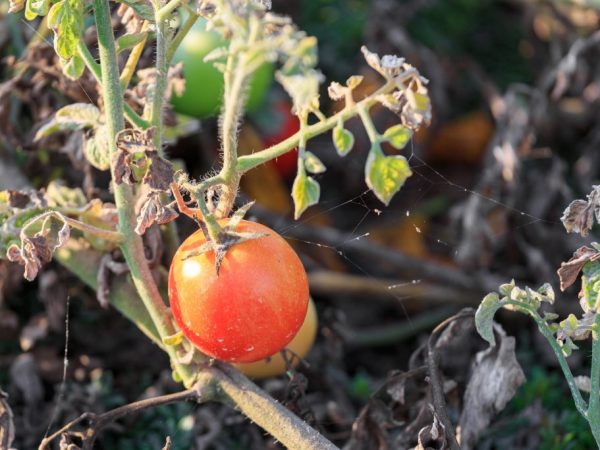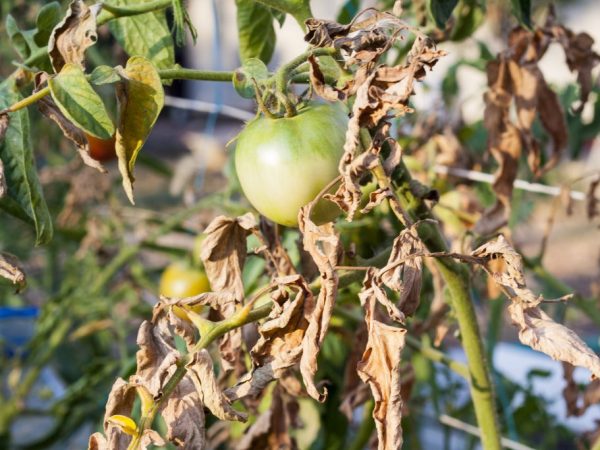How to deal with dried leaves on tomato seedlings
Tomato crops are among the most capricious: often the lower and upper leaves of tomato seedlings dry up, the bush stops growing, withers for no apparent reason and, in the end, dies. To prevent the death of the bush, it is necessary to timely monitor the appearance of dry parts and the change in the state of the entire bush as a whole.

How to deal with dried leaves on tomato seedlings
Causes of leaf drying
Insufficient watering and low humidity
The leaves of tomato seedlings dry out, because uneven watering and changes in humidity adversely affect the well-being of the plantings. This is especially true for plants growing in greenhouse conditions.
Lack of moisture leads to the appearance of yellowness and drying of some parts of the seedlings. It is necessary to water the plants at about the same time. Another way out is to install containers with water in the greenhouse: this will help keep the air moist. The humidity in the greenhouse should be around 28%.
High humidity and overflow
Excessive watering and high humidity are favorable conditions for the reproduction and growth of fungal diseases of tomatoes. Often, if the leaves of tomato seedlings dry, pest spores appear on the plantings and dark spots appear. Subsequently, the affected area dries out.
All the forces of the tomato are directed to the affected part of the seedlings, therefore the main stem becomes thin and brittle, and is strongly stretched. The plantings are weakening and withering.
Once the problem has been identified, it is necessary to monitor the ventilation mode, humidity and temperature in the greenhouse or greenhouse.
Watering rules for tomatoes
- Already strengthened bushes are rarely watered, but in sufficient volume: 5 liters per one bush 1-2 times a week.
- For young tomato plantings, daily hydration is suitable, because the root system is still superficial and not hardened. Until the first buds appear, watered in small amounts every day.
- The correct way of watering is with a thin stream under the root so that water droplets do not fall on the tomato leaves, thus exposing them to sunburn.
- For tomatoes in a greenhouse, it is better to use drip irrigation. It helps to retain moisture and distribute water evenly.
Influence of light conditions
Why do the tips of the leaves dry on tomato seedlings? Another reason is a violation of the light regime. With a short daylight hours, young seedlings lose chlorophyll, which is why the leaves begin to dry. To maintain proper lighting, special lamps must be purchased.
On average, with a 9-10 hour daylight hours, the lamps are turned on only early in the morning and late in the evening, if daylight is sufficient. For adults, excessive light is contraindicated: it leads to burns - it must be constantly adjusted.
Improper soil care

Plant health depends on soil quality
The soil in which they are found has a great influence on the health of tomatoes. An excess of trace elements or a lack of vitamins in the soil also have a negative effect on the condition of the bush. Do not violate the instructions for plant feeding. When applying the dry mix, ensure sufficient watering so that nutrients do not remain on the surface, creating a dense crust, but penetrate deep into the soil.
Excess salt also leads to the fact that tomato seedlings dry and curl leaves: salty soil does not allow air to pass through well and retains water in itself. A characteristic sign of an excess of salt is the appearance of a white bloom on the surface. To correct the situation, they bring in new soil and change the water source.
Fungal and viral diseases
Sometimes diseases and pests become the cause of wilting.
Phytophthora
Most often, tomato plantings attack varieties of fungal or viral diseases. Phytophthora is the most common infection. Its characteristic features include the appearance of brown spots and the subsequent drying of the leaves. Usually, plantings are infected during the period of heavy rains with high air humidity.
Prevention and treatment
The disease spreads quickly - all affected areas are immediately removed. The root zone is covered with nettle, as it absorbs moisture well, broken off places are treated with a phytophthora remedy. Sometimes it is better to remove the entire bush to save the rest of the crop.
Tobacco mosaic
Also, the leaves of the seedlings of domestic tomatoes dry out due to the tobacco mosaic. She appears in the middle of summer. When the mosaic spreads, the tops of the tomatoes first wither, then turn brown and yellow. A characteristic sign of the disease is the lace-like appearance of the leaves.
Prevention and treatment
In this case, only correct agricultural technology, timely removal of infected plants and the correct selection of seeds for the soil can help. Unfortunately, it is impossible to completely eliminate the tobacco mosaic.
Fusarium wilting
Fusarium wilting is another common infection. It is a fungus that feeds on cell sap. The stems turn brown, the leaves wither. With sufficient watering, the bushes look like they have dried up.
Prevention and treatment
Preventing the disease helps to maintain humidity in the region of 60-70% and a thermal regime up to the use of stove heating, if the temperature drops at night.
Pests
Mites and aphids can cause plants to dry out. For these parasites, the process of sucking nutrients from the body of tomatoes is very important.
Prevention and treatment
For processing, chemicals are used: acaricides and insectoacaricides. Spraying with a 2% lime mixture or fumigation with a sulfur stick is also useful if the tomatoes grow in a greenhouse.
Traditional methods of treatment

Infected plants must be disinfected
Garlic or laundry soap are used as folk remedies for the treatment of tomatoes. In 1 liter of milk, dissolve 25 g of grated laundry soap and add a few drops of iodine. The resulting solution is sprayed on the plants in the evening.
For the treatment of damaged plants, a mixture of real onion husks is also used. For 10 liters of water, 2 handfuls of onion husks are required, the mixture is boiled for 30 minutes. Plants are sprayed with a solution of room temperature.
Another folk remedy is treatment with a mixture of whey and water. Heated serum is diluted in 10 liters, after which the plants are disinfected.
A tincture of wood ash or any copper-containing composition can also help.
All folk remedies help only in the early stages of illness.
Tomato pickling
If, with proper care, the leaves continue to turn yellow, the pinching was carried out incorrectly. With such a problem, the leaves turn yellow in all tomatoes.
The formation of a bush must be dealt with when the shoots are young. It is better to cut off stepchildren in the morning, so that the wound has time to tighten during daylight hours. The most favorable weather is dry and calm. The processes that have appeared in the axil of the trunk are removed.
Work with gloves. The tool must be well sharpened.
Advice
So that next year the leaves of tomato seedlings do not dry out, in the fall, after harvesting, you should thoroughly clean the place of growing tomatoes, then remove the remaining shoots, bushes and disinfect them with a special solution or hot boiled water.
The yellowing of leaves on tomato seedlings can be caused by many reasons. If the problem is immediately detected, the plantings are easy to cure, the main thing is to find the right cause.


